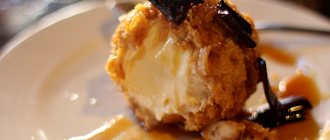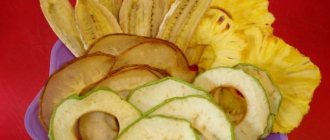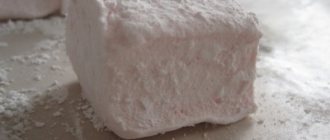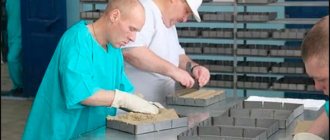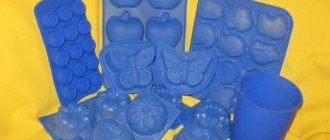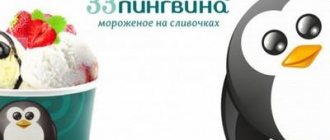As summer approaches, we crave ice cream more and more, and we eat kilos of it. Some people are not lazy and make it themselves, while the majority prefer factory-made ice cream.
However, if sanitary conditions, the condition of equipment and the quality of raw materials used for the production of ice cream may differ significantly in different factories, then the preparation technology remains approximately the same.
Now we are waiting for you with an impressive virtual excursion to the ice cream factory of the Inmarko brand (Unilever), accompanied by photographs and a video.
Kinds
Few people know the technology of ice cream production. The business of creating it is based on receiving seasonal income. For large factories this is very profitable, as well as for any other established production. Its preparation includes not only long-term, but also temporary costs.
If you decide to start working in this field, then first you need to buy a high-quality and functional line. All ice cream, depending on the production method, is divided into the following types:
- Soft.
- Creamy (seasoned).
- Homemade.
Advantages of a small ice cream business
Ice cream is a favorite treat for both children and adults. The popularity of the product ensures stable demand, however, the industry experiences a seasonal increase in consumption - from April to October. This should be taken into account when planning the launch of production - it is better to start in March in order to be at the peak of sales in the high season.
Ice cream production at a mini factory
Of course, competition in the industry is high, but in recent years, manufacturers have begun to move away from generally accepted manufacturing standards and come up with new and interesting flavor combinations to win over their consumers. Therefore, when opening your own mini-factory, you should focus on:
- originality of the product;
- taste qualities;
- bright packaging and design;
- conduct an aggressive marketing campaign.
In this case, you can hope for business success, and the investment will pay off in the first year of operation of the equipment.
Technological diagram of ice cream production
Placing a mini-line for the production of ice cream does not require large areas and the construction of a large enterprise, which is why there is such a wide variety of configuration options for mini-factories on the market.
Production processes
Everyone should know ice cream production technology. For industrial enterprises there is a characteristic list of sequential stages:
- preparation with further mixing of raw materials;
- filtration;
- pasteurization;
- homogenization;
- cooling;
- saving food until it is completely ready;
- freezing the mixture;
- packaging;
- hardening of dessert;
- packaging of finished food.
At the primary stage, the mixture itself is prepared. Next, the resulting mass is filtered and pasteurized. The product is then homogenized and cooled. When the mixture has completely hardened, it is sent to further stages of production: freezing, packaging, hardening and packaging.
The basic raw materials for creating ice cream are cream, milk, sugar and other ingredients. Their proportion depends on the prescribed recipe and technology. Large ice cream companies use several of these techniques. Each of them has its own specific functions.
Permits and documents
To relieve yourself of the problems of formalizing production, signing a lot of papers and approving premises, you can buy a nano-ice cream franchise - MilkyMoon's or Dippin'Dots. A franchise involves a simple process of starting a business: you do not have to create your own workshop from scratch, but only sell ready-made ice cream under a well-promoted brand.
On the other hand, if you want more independence and develop your own retail network, then you can open your own production from scratch.
Business registration
In both cases, you first need to register yourself as an individual entrepreneur. Choose a simplified form of taxation, and OKVED codes will depend on the type of business: sale of nano-ice cream under a franchise or independent production.
List of documents for individual entrepreneur registration
- Application for state registration of an individual as an individual entrepreneur (form No. P21001)
- Copy of Russian passport
- Receipt for payment of state duty
Portion method
What is portion technology for producing ice cream in production? When the above technique is applied, all components of the ice cream mixture are prepared and a fine emulsion is formed. Next, it is pasteurized, homogenized, cooled, and then sent to ripen. Then served for freezing.
The highest productivity of a large company in this case is about 130 kg of product per 1 hour of line operation.
We continue to study the technology of making ice cream in production. First of all, the mixture to create a delicious dessert enters in fluid form into mixing containers through a special revival section of the heat exchange apparatus. During this stage it heats up to 40-45 °C. In this case, the fatty ingredients are first dissolved in an oil-melting device, and then passed through a dispersant into special containers.
Dry ingredients are also sent to this bunker, which are then mixed in the stream with the primary mixture and fats. The result of all processes is an emulsion. The ice cream mixture is then pasteurized in containers where steam is supplied through a bubbler designed for this purpose.
When the process is completed, the ice cream is sent through a pump to a homogenizer, where it undergoes filtration. Afterwards, the dessert mass goes to the regeneration unit of the plate heat exchanger. It comes here already cleared of undissolved lumps. The partially cooled mixture is sent to the heat exchanger for final cooling to 5-7 °C.
Portion technology for preparing ice cream has the following advantages:
- the cost of a set of equipment is not so high;
- Thanks to the low level of automation and the simplicity of the design itself, the entire process of creating dessert is as reliable as possible.
Equipment purchase
As a result of an analysis of the market for technological equipment for the production of ice cream, the most acceptable is the purchase of domestically produced equipment - an automatic line with a raw material processing capacity of 1000 kilograms per shift.
The advantage of this line is the ability to perform almost all production operations on it, with the exception of packaging of finished products.
Sales of finished products will be carried out through specialized wholesale companies and regional retail chains.
Calculation of costs for the purchase of production and technological equipment:
| № | Type of equipment | Unit price (RUB) | Number of units required | Total (in rub.) |
| 1 | Raw material component mixer | 406 150 | 1 | 406 150 |
| 2 | Capacitive filter | 26 500 | 1 | 26 500 |
| 3 | Device for melting oils ARZH-MI-0.3 | 193 100 | 1 | 193 650 |
| 4 | Homogenizer RPG 7.5 kW | 80 100 | 1 | 80 100 |
| 5 | Pasteurizer VDP-1000 l | 404 300 | 1 | 404 300 |
| 6 | Container with cooling jacket and thermal insulation for product ripening | 412 700 | 1 | 412 700 |
| 7 | Shut-off valves | 168 400 | 1 set | 168 400 |
| 8 | Pumps | 45 100 | 4 | 187300 |
| 10 | Freezer with a capacity of 1 t/cm | 860 700 | 1 | 860 700 |
| Total | 2 739 800 | |||
Additionally purchased:
- Packaging technological line worth 560 thousand rubles.
- Two sets of Polair refrigeration equipment with a total cost of 330,080 rubles.
The purchase of this equipment will ensure the implementation of all operations of the technological cycle of ice cream production, which includes:
- Checking, preliminary preparation of raw materials and their mixing.
- Filtration, pasteurization and homogenization of the mixture.
- Optimal conditions for cooling and storage.
- Freezing and packaging of products followed by hardening.
- Packaging.
Production of different types of dessert
Since we are talking about a popular product, the technology for making ice cream is of interest to many people. There are several varieties of chilled products: milk, cream, aromatic (no dairy raw materials), berry-fruit, ice cream based on milk mixture with different fat content (from 2 to 15%). In addition, it is produced in different packaging: large-packaged (cakes, ice cream in boxes or plastic bags), small-packaged (coated with chocolate, in a briquette, cup, etc.), by weight.
Depending on the taste properties of the components used, dessert can be of the following types: with raisins, additives, candied fruits, with filling, fruits, nuts, and so on.
Production can also be classified according to the manufacturing method - single-layer, multi-layer, decorated and food-coated. Sometimes you can find fermented milk ice cream on the shelves. The creation of this sweet dessert, depending on the starters and raw materials used, can be divided into sour cream, acidophilus, kefir, yoghurt, fermented baked milk, curd and others.
If different vitamins are added to ice cream, it is called fortified. When the label says “fragranced,” it means the product contains flavorings.
Making ice cream at home
Culinary enthusiasts are attracted by the technology for producing creamy ice cream at home. This dessert appeared in the 13th century in Europe, although frozen fruit was already enjoyed in Ancient China. It can come in mint, coffee, chocolate, fruit, caramel, berry, vanilla, green tea, or nut flavors.
The ice cream with cookies, cognac, halva, bizet, dried fruits and candied fruits is very tasty. In some restaurants you can taste ice cream made from carrots, rose petals, ginger, pumpkin, spices, honey and coconut. How to make this dessert with your own hands? This is a very troublesome business, so some housewives buy special electric ice cream makers. This is very convenient - just add the necessary products, install the program, and the creme brulee, ice cream or ice cream is ready in a while.
The main convenience of the device is that it simultaneously beats the mass and freezes it. After all, without this, it will not turn out homogeneous; there will be tiny ice crystals in it.
However, not everyone can purchase ice cream production equipment. The technologies for its creation, however, make it possible to do without it. You just need to whip the cream with a mixer and set the freezer to the desired temperature.
Equipment
| Equipment | Cost, ₽ |
| Ice cream making machine | 250’000 |
| Refrigerators for storage | 100’000 |
| Furniture | 40’000 |
| Dishes | 10’000 |
| Scales | 5’000 |
| Package | 7’000 |
| Lighting and other little things | 15’000 |
| Refrigerator for sale | 30’000 |
| Awning over the point of sale | 8’000 |
| Cash register with acquiring | 35’000 |
| Total | 500’000 |
Making your own ice cream
What is the technology for producing ice cream “Plombir” at home? This dessert, made with your own hands, is much healthier and more appetizing than store-bought. The amount of sugar can be changed depending on your preferences and tastes. We take:
- 500 ml milk;
- 250 ml heavy cream;
- vanillin;
- five eggs;
- 100 g powdered sugar.
Many housewives were convinced from their own experience that the technology for producing ice cream “Plombir” turned out to be not so complicated. To prepare a refrigerated product, follow these steps:
- Separate the yolks from the whites.
- Mix the yolks with sugar and a pinch of vanillin, grind well to get the same type of mass.
- Boil the milk and pour it into the egg-sugar mixture in small portions, stirring constantly so that the yolks do not curdle.
- Cook the milk mixture over very low heat for three minutes until it thickens and becomes identical to liquid sour cream. Do not boil under any circumstances, otherwise the yolks will cook.
- Cool the mixture to room temperature and then place in the refrigerator.
- Beat the chilled cream to stiff peaks with a mixer.
- Combine the milk and egg mixture with the cream and stir well.
- Place the mixture in the mold and refrigerate.
- In the first 1.5 hours, stir the mixture with a mixer every 20 minutes. Then put the ice cream in the refrigerator for another 3 hours, repeating the stirring process every hour.
Now invite your loved ones to the table and serve ice cream with nuts, fruit syrup, chocolate, dried fruits or pieces of fruit.
Formalization of the project
The created ice cream production will operate within the framework of the legal form of individual entrepreneurs. This is due to the possibility of using a simplified registration procedure and does not require the collection of a large number of permits.
The most acceptable form of taxation is the simplified tax system, in accordance with which the following is paid:
- Income tax – 13%.
- Profit tax of 15%.
- UST – in the amount of 32% of the wage fund.
The tax return is submitted once a year (April of the year following the reporting period).
Initial calculation data for the project:
- The volume of required capital investments is RUB 6,379,800.
- The projected net profit is RUB 356,143.
- The amount of revenue (on average for 1 month) is 4,070,000 rubles.
- The projected payback of the project is 18 months.
Freezers
Many cafes make ice cream using Polair chest freezers. These devices are called freezers and their manufacturers produce various modifications. Among the offered devices there are not only those intended for installation in a cafe, but also for use in everyday life. For example, the Gastrorag freezer is produced for creating ice cream in huge quantities.
However, among the brands of equipment offered, you can also find a suitable option for installation at home. There are versions that will perfectly fit into the design of the kitchen, and the bowl, whose capacity is only 1.5 liters, is suitable for feeding your loved ones a delicious dessert.
Business profitability
In addition to capital costs, you need to be prepared for the following monthly expenses:
- wages - with a staff of 15 people, monthly expenses will be approximately 300 thousand rubles;
- social contributions - 50 thousand rubles;
- rent of premises with an area of 200 m2 – 150 thousand rubles;
- advertising and transportation costs – 225 thousand rubles;
- utility bills - 15 thousand rubles;
- payment for accountant services – 25 thousand rubles;
- additional expenses – 50 thousand rubles.
Total monthly expenses will be 815,000 rubles. The cost calculation includes the electricity consumed by ice cream machines and the price of products. For 1 ton of sweet delicacy you will need about 9 tons of ingredients (this includes milk, cream, sugar and other components).
The average wholesale price of a unit of raw materials (kilogram, liter) is 14 rubles. The daily consumption will be 9 × 14 = 126,000 rubles. There are approximately 22 working days in a month. You will need 2,772,000 rubles for raw materials.
The cost also includes the cost of using electricity. The cost of kW is 3.5 rubles. The average consumption per shift will be 4,200, and per month (based on 22 working days) - 92,400 rubles. Total monthly cost is 2,864,400 rubles.
Is an ice cream business plan feasible and what kind of revenue can you expect? The average price for 1 kg of ready-made delicacy is 185 rubles. That is, you can earn 185,000 rubles per shift, and 4,070,000 rubles per month (22 shifts).
Profit per month will be: 4,070,000 – 2,864,400 = 1,205,600 rubles. Expenses – 815,000 rubles. Then we subtract 15% tax from the profit. The projected income is 332,010 rubles. With such earnings, you can recoup your investment in 1.5–2 years.
Ice cream "Clean Line"
What are the features of the Clean Line ice cream production technology? The delicacy from a well-known company is valued not only for its large assortment and bright taste, but also for the high quality of the product, which meets the strict requirements of GOST and standards. This success was achieved thanks to the use of only natural ingredients and special technology for making the dessert.
The process of creating ice cream begins with the choice of milk. The company has been cooperating with several farms in the Moscow region for a long time and takes an active part in the life of manufacturers. The properties of milk depend on the diet of cows, so in summer they feed on lush grass far from the metropolis in clean meadows. In winter, the company provides farms with special balanced feed, which includes hay and grains. There are no chemical additives or GMOs in the feed; medications and antibiotics are also not used. In addition to nutrition, much attention is paid to animal health - cows lead an active lifestyle. They are provided with the required and regular care.
At the ice cream plant, the main product arrives a couple of hours after the cows are milked. The company uses its own milk tankers, which are equipped with mini-laboratories. With the help of such equipment, primary tests are carried out already at the time of milk collection. Upon arrival, the food is again examined in the factory’s laboratories and also sent for independent examination.
Mixes for making ice cream
Most freezers work on mixtures that are poured into the bowl and diluted with water or skim milk. In order not to be mistaken with the quality of the product, we recommend purchasing mixtures from the following companies:
- Comprital
- Pregel
- Ace dream
- Giord
These manufacturers produce a wide range of flavors with different additives and flavorings, allowing the confectioner’s imagination to run wild. In addition, some freezer models allow you to fill ice cream with syrups and jams.
Stages of creation
How is ice cream made at the Clean Line enterprise? The tested milk is sent for pasteurization. To do this, it is poured into a tank, which is heated to 92 °C. Such a gentle process allows you to remove all harmful bacteria from the raw material, but at the same time preserve all the beneficial qualities.
Pasteurized milk is moved to a workshop where it is combined with other components (cream, condensed milk). Next, the mass is boiled for 40 minutes and sent to a homogenizer for mixing. Current equipment makes it possible to obtain a delicate and uniform consistency.
Next, the mass is cooled with ice water and sent to ripen for a couple of days. Then the ripened milk mixture is moved to the molding shop, and then to the packaging shop, where all actions are carried out manually.
The packaged ice cream undergoes final freezing in approximately 40 minutes and then is ready for shipment.
The Clean Line factory is equipped with automated equipment and modern production lines, which are subject to maintenance and regular inspection. All workshops have strict control over the production of sweet desserts, which guarantees compliance with all standards and requirements for product creation. “Clean Line” ice cream is a combination of classic ancient recipes and innovative technologies, which allows you to achieve a pleasant texture, convey all the taste properties and at the same time preserve all vitamins and microelements.
Actually, how is ice cream made?
The finished milk, cream or vegetable-fat mixture from the tank in which it matured passes through pipelines into a freezer, in which it is whipped and saturated with air bubbles. The next step is to dose the ice cream mixture into special containers (containers, waffle cups, waffle cones, plastic bags)
or in the case of popsicle, squeezed portionwise onto metal sheets.
Portioned soft ice cream is immediately sent to the freezer, where it is frozen for 30-50 minutes at a temperature of -18-20°C, and again returned to the same place where it began to be dosed.
Ice cream that needs glazing (chocolate or flavored glaze) is dipped in it when it comes out of the freezing chamber. The glaze hardens immediately.
Now the task of the personnel working on the ice cream production line is to repackage the ice cream in colorful film or in a painted cardboard package and make sure that the date and time of production of a serving of ice cream is printed on each package. The finished ice cream is put into boxes of a certain number of pieces, no more and no less.
It’s very interesting to watch this process, but packaging the products is quite difficult; dexterity is required, since ice cream is packed very quickly.
Ice cream boxes go through metal detectors that detect any metal in the product or box. Therefore, the likelihood of buying an ice cream maker with wire is very low!
Next, the boxes are sent along a constantly moving conveyor to the hardening chamber. The temperature there is of course very sub-zero, -30-35°C.
Next, the ice cream goes to the finished product storage warehouse, where the air temperature is also quite low, and is stored there until it is sold to retail chains.
During the production of ice cream, the quality control department necessarily selects arbitration samples of ice cream during the entire production process and sends them to the same storage conditions as boxes for sale in trade. This is done so that in the event of a complaint from a buyer or a retail outlet (for example, a complaint about the low weight of a portion, or crooked ice cream that has melted and frozen again, and so on), it is possible to check whether such a mistake was actually made during production. This is often the fault of retail outlets that improperly transport and store ice cream.
Compound
In many cookbooks, ice cream production technology is described in as much detail as possible. You can also find the composition of this product there. What is ice cream made from? With strict adherence to GOSTs, the current cold dessert consists of:
- from milk with at least 10% fat content;
- sugar (12-16%);
- milk solids (9-12%) such as lactose and proteins (casein and whey proteins);
- water (55-64%);
- emulsions and stabilizers (0.2-0.5%), increasing the shelf life of the treat.
All these components, together with the air that enters the mass during the mixing process, make up the ice cream. Some types of dessert, made according to all the laws of culinary art, contain calcium (13.6%), vitamin B2 (11.1% of the daily requirement), phosphorus (12.6%), potassium (5.9%).
The dessert, created on the basis of animal fats (milk and cream), stimulates the body to produce the hormone of happiness - serotonin, which helps cope with the destructive effects of depression and stress.
Selecting premises and hiring staff
The most appropriate option at the initial stage of building a business is to rent premises. For the high-quality organization of the ice cream production process and the work of administrative personnel, a premises of at least 200 square meters will be required. m. A special condition is that in the production workshop the ceiling height must be at least 3.5 meters (this is required by the technical regulations of production equipment).
In addition, it must have power supply (380 V), sewerage and comply in its characteristics with SanPiN 2.3.4.551-96 standards.
An additional requirement is the availability of a convenient access road for the company’s vehicles, suppliers of raw materials and distributors of finished products.
For efficient and self-sustaining operation of the enterprise during one-shift operation, 15 employees are required, including:
| Job title | Number of staff units | Salary size | |
| Head of the enterprise (IP) | 1 | 35 000 | 35 thousand rubles. |
| Director of operations | 1 | 30 000 | 25 thousand rubles. |
| Process engineer | 1 | 25 000 | 30 thousand rubles. |
| Head of Sales Division | 1 | 25 000 | 30 thousand rubles. |
| Sales department | 2 | 20 000 | 40 thousand rubles. |
| Storekeeper | 1 | 20 000 | 20 thousand rubles. |
| Workers | 5 | 15 000 | 75 thousand rubles. |
| Loaders | 3 | 12 000 | 36 thousand rubles. |
| Total | 15 | 291 thousand rubles. |
Energy value
How many calories does ice cream contain in a cup? Their number in a product depends on its creation method, type and presence of additives. Thus, simple creamy ice cream has up to 150 kcal, ice cream – up to 240 kcal per 100 g. If the product contains fruit additives, its calorie content increases by 10-20%. Ice cream with white glaze or chocolate will cost up to 270 kcal. Dairy ice cream has the lowest energy value - 120-130 kcal.
Chocolate ice cream has a calorie content of 231 kcal per 100 g of product, Creme Brulee ice cream - 240 kcal, with nut filling - 230 kcal, and with fruit filling - only 206 kcal.
It should be noted that the energy value of the ice cream is very high due to the fact that heavy cream is used in its production. Therefore, this kind of sweetness is not suitable for people who are overweight and have impaired metabolism. Ice cream is the fattiest variety of the dessert we are considering. Don't forget about the waffle cups in which the classic mixture is usually served. The calorie content of one such edible package is approximately 341 kcal per 100 g.
Relevance of the business idea
The demand for ice cream is always high, but it strongly depends on the season: in the summer there is a peak in sales, while in the winter they are almost zero.
But during the summer period you can work 100% so that in winter all you have to do is relax and think about the strategic goals of your business for the next year. Nano ice cream differs from regular cream ice cream in the method of preparation: fruit juice is frozen using nitrogen at a temperature of minus 70 degrees Celsius.
This is how small bright colored balls are obtained, which are eaten from cups with a spoon. Due to its amazing appearance, novelty and unusual taste, this project wins.
Hard ice cream
And finally, I would like to mention the technology for the production of hard ice cream. The process of creating it is essentially quite similar to the technique for making a seasoned dessert, but it is a little simpler. To make hard ice cream, you need to perform the following technological processes: prepare raw materials, make a mixture, homogenize it, pasteurize it, cool it, ripen it and freeze it.
The finished dessert is unloaded from the freezer into gastronomic containers, and then sent either for sale or for additional hardening. The creation time for one batch of product is only 30 minutes.
Traditional hard ice cream is sold from refrigerated display cases in the form of beautiful multi-colored balls. They are formed from a mass of different varieties of dessert using special dispensing spoons. The delicacy is decorated with grated chocolate, various toppings, pieces of fruit, sprinkled with nuts and other goodies. It is almost impossible to list the entire existing range of types of artisanal ice cream, much less try it.
